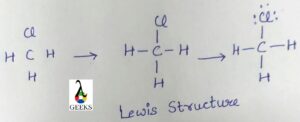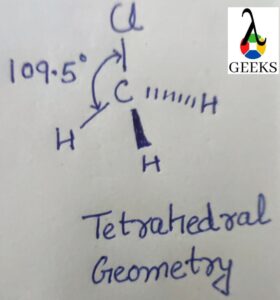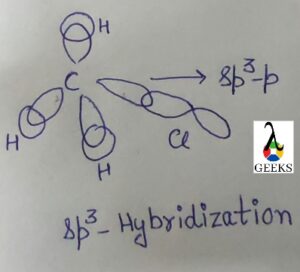This article is related to Ch3cl lewis structure, its characteristics, and other important properties which explain Ch3cl molecules.
Ch3cl(methyl Chloride) or Commonly called Chloromethane.Ch3cl is a very reactive haloalkane compound. Ch3cl lewis structure is highly reactive and combustible.
Chloromethane is a gas that resides in the air for only 10 months. Ch3cl lewis structure produced 25% of chlorine in the environment by emission. This gas has a strong aroma and appears colorless at dangerous concentrations.
How to draw Ch3cl lewis structure?
Ch3cl lewis structure explains the valence electrons that are present in the valence shell of an atom. Valence electrons are used in the bond formation to create the different molecules.
Lewis structure is drawn by dots which represent the valence electrons assigned around the elements present in the molecules.
Through lewis structure, we can predict that bonds formed between atoms are single, double, or triple bonds.
For drawing the lewis dot structure we conclude the electronic configuration of each atom and find out the valence electrons in them.

Electronic configuration of C, H, and Cl.
C: 1s2,2s2,2p2 (4 valence electrons)
H: 1s1(1 valence electrons)
Cl: 1s2,2s2,2p2 ,3s6,3p5 (7 valence electrons)
Central atoms are those whose electronegative value is less, C with a less electronegative value of around 2.0 than Chlorine with 3.2.
So in the Ch3cl lewis structure, Carbon(C) is in the center, and Hydrogen and Chlorine are scattered around it.
Ch3cl lewis structure resonance
Chemical resonance structures are composed of two or more Lewis Structures representing the electronic bonding of a single polyatomic species as well as fractional bonds and fractional charges.

During the resonance structure, the central atom should be the least electronegative. So in the ch3cl lewis structure carbon is the central atom and least electronegative than other atoms like hydrogen and chlorine. Place all the valence electrons in the atom and distribute them like the completion of the octet take place for each atom.
Ch3cl lewis structure shape
The number of electrons involved in bond formation in an atom represents the molecular geometry of that molecule. Determining the shape of a molecule can be discovered by using VSEPR or VBT(valence bond theory).
According to these theories, a molecule shows a similar structure as AX4 as 4 negatively charged centers in molecules. So, this kind of structure follows a tetrahedral shape. So, tetrahedral geometry exhibit a 109.5° angle.

When we discuss ch3cl lewis structure molecules it also shows tetrahedral geometry and bond angle of 109.5°.
In the ch3cl lewis structure, carbon is the central atom with four valence electron and participate in bond formation with another atom like hydrogen or chlorine.
Thus Ch3cl lewis structure shows four negative centers following VSEPR theory and shows a tetrahedral shape which shows the maximum separation of an electron to overcome the repulsion and formation of the stable molecule.
Ch3cl lewis structure formal charge
The formal charge is the mathematical calculation of the actual charge that is present on each atom present in given molecules.
In the case of Ch3cl lewis structure, firstly calculate the formal charge of carbon because carbon atoms act as the central elements being less electronegative than chlorine.
- Carbon has 4 valence electrons act as a central atom and uses 8 electrons in bond formation and does not contain any nonbonding electrons.
- Chlorine has 7 valence electrons more electronegative scattered around carbon and 2 bonding and 6 nonbonding electrons.
- Hydrogen has only 1 valence electron and 2 bonding and 0 nonbonding electrons.
| Formal Charge on elements in Ch3cl Molecule | = | Number of Valence electrons | – | Number of nonbonding electrons | – | ½ Bonding electrons | = | Calculated formal charge |
| C | = | 4 | – | 0 | – | 8/2 | = | 0 |
| Cl | = | 7 | – | 6 | – | 2/2 | = | 0 |
| H | = | 1 | – | 0 | – | 2/2 | = | 0 |
Ch3cl lewis structure angle
In the ch3cl lewis structure having general formula is AX4, 4 single bonds with no lone pair on the carbon atom act as the central atom.
In Ch3cl lewis structure determines the geometry using VSEPR theory, so observed tetrahedral geometry, thus this geometry consists of 109.5° angles.

This angle is due to the polarity of the C-Cl bond that acquires a partial negative charge on the chlorine atom and this is due to the maximum electronegativity of chlorine than other atoms like carbon and hydrogen.
Thus Ch3cl lewis structure consists of 109.5° bond angles.
Ch3cl lewis structure octet rule
In the ch3cl lewis structure carbon requires 4 electrons to complete its octet, having 4 valence electrons in its outermost shell.
Hydrogen complete duplet, this is the exception to the octet rule and chlorine retired only one electron to complete its octet. Thus, the central atom does not consist of any lone pair of electrons and there are 4 single bonds with no lone pair on central atoms.
Ch3cl lewis structure lone pairs
Ch3cl lewis structure, in this no lone pairs are present on the central atoms.
Ch3cl lewis structure: Carbon(C)= Zero lone pair because it is the central atom.
Ch3cl valence electrons
The valence electrons are those electrons that are used to draw the lewis structure of the molecules by considering the electrons of each atom.
In the Ch3cl molecule, there are 14 valence electrons in total by combining the valence electrons of central atom carbon and scattered atoms like chlorine and three hydrogens.
There is no lone pair present on the carbon atom when we assign the valence electrons and complete their octet.

Valence electron in Ch3cl molecule=14
Valence electron in carbon =4(1s2,2s2,2p2)
Valence electron in chlorine =7 (1s2,2s2,2p2 ,3s6,3p5 )
Valence electron in hydrogen =1(1*3)= 3 (1s1)
Total valence electron = 4 + 3 +7
=14
Thus Ch3Cl lewis structure has 14 valence electrons in total.
Ch3cl hybridization
Hybridization is the result of combining and mixing different atomic orbitals of different chemical elements to create new hybrid molecules.
In the Ch3cl lewis structure, carbon is the central atom with the hybridization of sp3.
In the chloromethane(Ch3cl) there is no lone pair and consists of four single bonds.
For finding the hybridization we use the formula:
Hybridization = No. of bonds in the molecules + No. of lone pairs present at the central atom.

Ex: Ch3cl(Hybridization of C(central atom)) = 4+ 0 = 4(sp3).
In the Ch3cl molecule, there is no lone pair on the central atom due to the symmetrical distribution of electrons.
Ground state electronic configuration of C: 1s2,2s2,2p2
Excited state E.C of C: 1s2,2s1,2p3
Thus combining it leads to forming of four hybrid orbitals of the same energy level. Thus the hybridization of C in Ch3cl= sp3.
Ch3cl solubility
Ch3cl lewis structure is slightly soluble in water it is like 5g/l and be drawn into a complete solution.
This is because of its dipole moment, so it contains less no. of a chlorine atom to withdraw the electron density towards chlorine so less polar and due to which in sufficient hydrogen bonding will occur in this molecules. This result in less solubility of the Ch3cl in water.
It is soluble in organic solvents like benzene, acetone, etc.
Is Ch3cl ionic?
Chloromethane is an ionic compound due to the electronegativity difference between the carbon and chlorine atom.
The value of electronegativity of carbon is 2.0 and that of chlorine is 3.0. So the difference is more and exists in the form of ionic bonds like c-cl.
Thus Ch3cl lewis structure is the ionic molecule.
Is Ch3cl acidic or basic?
For a molecule to be acidic either it accepts the electron or donates the electron, but in the case of the Ch3cl molecule, there is the generation of dipole moment which shows charge and distance relation.
There is more dipole in the case of Ch3cl molecules, hence it is acidic.
In Ch3cl molecules, CH3 acquires +ve charge due to electronegativity difference and Cl acquires -ve charge.
CH3Cl ——> CH3+ẟ +Cl-ẟ
Is Ch3cl polar or nonpolar?
Charge separation results from large differences in electronegativity between the two participating atoms of polar molecules.
The difference between the electronegativity value of C& Cl is more so that the C-Cl bond is polar. It will be shown through net dipole, net dipole is toward the chlorine atom and does not cancel so, the Ch3cl molecule is polar.

Considering the structure of Ch3cl lewis structure, it can be noticed that Carbon with sp3 hybridization acquires tetrahedral geometry with 109.5 bond angles.
So this will show each bond pair will show its different dipole and electronegativity difference, hence the total dipole is toward the chlorine and it is considered to be polar.
Thus due to the C-Cl bond being polar, the Ch3cl molecule is polar.
Is Ch3cl tetrahedral?
The Ch3Cl molecule is composed of a tetrahedral molecular geometry or shape, because of the presence of one Carbon-chlorine and three Carbon-hydrogen bonds. As the three hydrogen atoms and one chlorine atom are linked in a tetrahedral form.
Thus Ch3cl lewis structure is tetrahedral geometry.
Is Ch3cl linear?
Ch3cl has tetrahedral molecular geometry and shape with a non-linear structure.
Sp3 is the hybridization of chloromethane or methyl chloride(Ch3cl). It has a tetrahedral molecular geometry or shape. one C-Cl bond and three C-H bonds are present in this geometry. These bonds are spread out so that there is minimal repulsion between them. Chloromethane having Ch3cl lewis structure is in the form of gas in the air, used in refrigerators previously.
Also Read:
- Ccl3f lewis structure
- Ca2 lewis structure
- Pf5 lewis structure
- Pcl3 lewis structure
- Ccl2f2 lewis structure
- Fecl2 lewis structure
- Snf3 lewis structure
- Xef6 lewis structure
- Nah lewis structure
- Ba2 lewis structure

Hi….I am Monika. I have done Masters in Chemistry. I am a Subject Matter Expert in Chemistry. I would say that I am a very passionate writer. The main goal of my writing is to present new perspectives. I want to discover new things that I can apply to my surroundings.
Let’s connect through LinkedIn